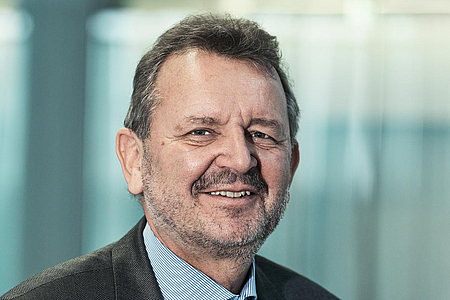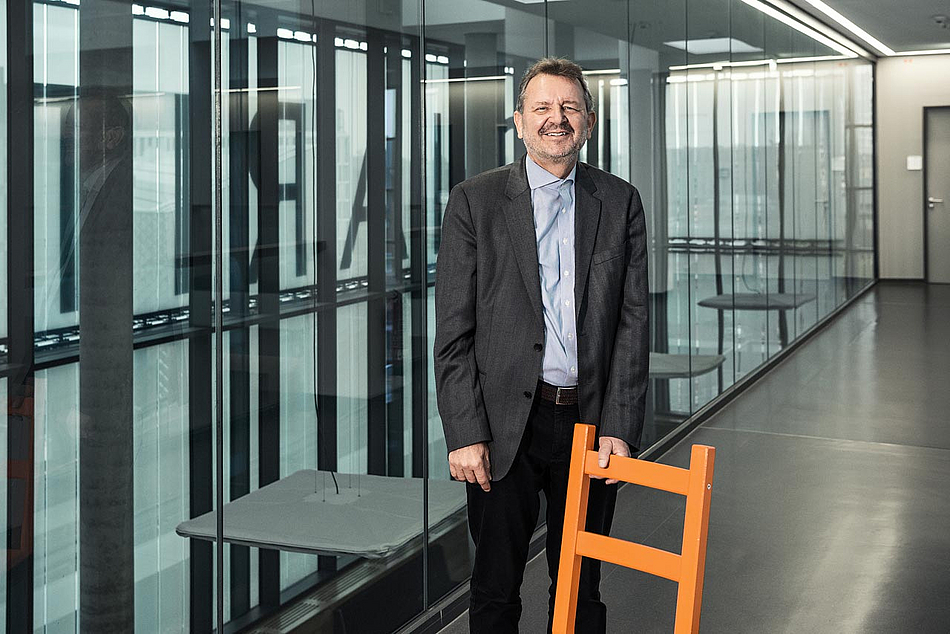The role of epigenetic software in researching rheumatism
Steffen Gay is spending several months in Berlin as a BIH Visiting Professor to conduct a clinical study on patient responses to different rheumatism medications at the Charité. During his stay in Berlin, the Leipzig-born scientist, who trained at the Max Planck Institute in Munich-Martinsried, told us what brought him back to Germany after over 40 years abroad.
Professor Gay, when one looks at your career, places with recent historical associations come up again and again. What sort of things have you experienced there?
In the days of communist East Germany, I grew up in the Erzgebirge mountains and studied medicine in Leipzig. Together with my wife, who also studied medicine, we both continued our training in Munich. There, I did research into connective tissue diseases. In connection with that, I was able to determine the distribution of the structural proteins in collagens in different human tissues, using fluorescence-marked antibodies. But also, I always wanted to go to America. As there was interest in my technology over there, I was subsequently awarded a scholarship grant by the German Research Foundation to introduce this fluorescence technology in Birmingham, Alabama. Birmingham does remind one of racial issues and the Ku Klux Klan, which was very active there. However, the research at the University of Alabama (UAB) was excellent, under the outstanding leadership of J. Claude Bennet (who, incidentally, also helped to build up the German Rheumatism Research Center here in Berlin), which is why we spent so many years of our scientific career there – 20 to be precise. In particular, the governor of the time, George Wallace, expanded heart surgery and the cancer center, so that the Clinical Immunology/Rheumatology Department of the UAB became one of the largest worldwide.
You now work in Switzerland. What lured you away from the USA and back to Europe?
22 years ago, I was offered the chance to become the director of a research center as Professor of Experimental Rheumatology in Zurich. I found the field of epigenetics particularly fascinating. An interesting job opportunity also opened up for my wife in Switzerland and we followed the call.
Could you explain what epigenetics is in layman’s terms?
Our DNA is packaged in chromosomes and wound around tiny balls, otherwise it would be about two meters long. Only two per cent of it is used: the rest was long termed “junk DNA”. Today, we know that genes are turned on and off. These regulatory processes are called epigenetics. Our current knowledge largely consists of studies that state which gene is associated with which disease. We don’t know precisely how that specific disease is triggered. Each gene has a kind of traction engine, called a “promoter”. If methyl and acetyl groups attach themselves to these, no further other substances can attach to switch on the gene. There are about two million such switches in the human body for methyl groups alone, and if those aren’t working, you fall ill. I’m often asked whether regulation is therefore more important than genetics. It’s similar to asking whether the hardware or the software in a computer is more important...

Funding program
BIH Visiting Professors
Funding period
2017 – 2018
Research areas
Rheumatology, clinical immunology, allergology
Project title
Development of novel biomarkers for the detection of response to anti-rheumatic drugs: development of a methylation FACs staining assay
Institution
UniversityHospital Zurich (USZ) and Department of Rheumatology and Clinical Immunology, Charité – Universitätsmedizin Berlin
Since 1996
Professor of Experimental Rheumatology, UniversityHospital Zurich (USZ), CH
1984 – 1996
Professor of Medicine, Division of Clinical Immunology and Rheumatology, University of Alabama at Birmingham, Alabama, USA
1972
Medical degree, University of Leipzig, Germany
...so, is epigenetics the software? What exactly is your current focus of research?
In the field of rheumatology, I’ve closely followed the entire process of developing pharmaceutical products. Rheumatism medication cost up to 20,000 euros a year, but the disease is incurable and only 60 per cent of patients respond fully to the therapy. We’re therefore studying the switching mechanisms I just described. In the case of rheumatoid arthritis (RA), certain cells of the affected joints, the fibroblasts, eat into the cartilage and the bone. We’ve been able to show that many methyl groups are missing in these cells, as a result of which inflammatory processes are switched on and the cells become aggressive.
We want to measure these joint activation processes in the blood too. That’s why we are studying whether the inflammatory cells that migrate from the blood into the joint have fewer methyl groups and are therefore able to bind more activating substances. We observe patients to see whether the degree of methylation increases in the course of the therapy. If it doesn’t change and the symptoms don’t decrease, those patients are called “non-responders”. Then you could cancel the medication, because it won’t work.
Why did you decide to carry out the study in Berlin?
In Zurich, we do more basic research, so we don’t have such a large clinical trial unit. It calls for a huge infrastructure: here in Berlin, the patients are asked to come for the therapy, and a blood sample is taken and has to be examined within 1-2 hours – all in one day. 14 or 28 days later, the whole thing is repeated. Cooperation with the Charité was essential for conducting the project. The German Rheumatism Research Center here in Berlin is ideally equipped for these time-consuming trials, and we can carry them out there.
What are you hoping to achieve with your research?
Ultimately, we want to bring our research to the patients. This is why we are trying to implement our basic research in new therapy strategies and patents. The aim is for our results to help improve the therapy situation for rheumatism and for patients to be spared having to undergo ineffective therapies in the future. The Rheumatism Research Center is attached to one of Europe’s largest university clinics, which attracts patients from the whole region. I also think it’s important to interact with international colleagues and to learn from one another. In order to be innovative, you need outside opinions on your research projects. That was another reason why the Charité was an important location for our study.
November 2017 / MM
